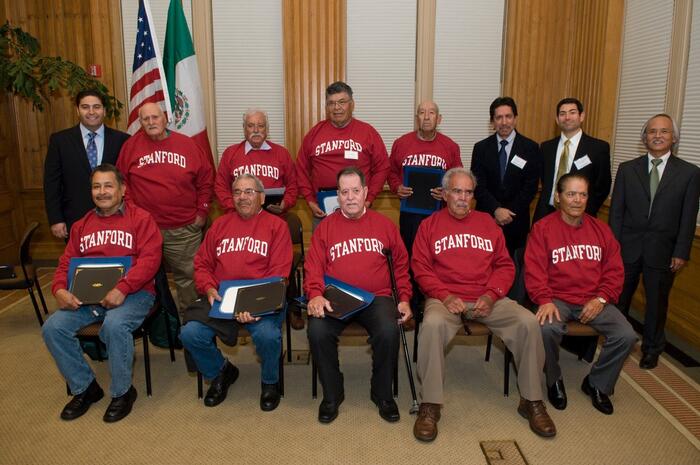The Bracero Program, 1942–1964
My grandparents, who were immigrants from Hiroshima, Japan, were migrant farm workers and sharecroppers in California from the early 20th century, and they lived in many towns in California. The only other state that they lived in was Arizona when they were incarcerated by the U.S. government from 1942 to the end of World War II in 1945 in what were once called “relocation centers” and now usually referred to in U.S. history textbooks as “internment camps” for people of Japanese descent primarily from the West Coast. My parents, who were born in California and thus U.S. citizens, were also incarcerated. Because Japanese immigrants and their descendants played such a vital role in agriculture in states like California, the incarceration of approximately 120,000 people of Japanese descent—along with the military draft—caused a severe labor shortage in agriculture. These were two of the key reasons for the establishment of the Bracero Program in 1942. SPICE Consultant Dr. Ignacio Ornelas Rodriguez, who teaches at Willow Glen High School, San Jose Unified School District, as well as at Stanford University, noted:
The Bracero Program was a series of laws that allowed the United States to recruit temporary guest workers (braceros, lit. “individuals who work with their arms”) from Mexico. As the United States entered World War II, its agriculture and railroad industries witnessed a shortage of laborers due to the U.S. military draft and the forced removal of Japanese Americans from the West Coast of the United States. The United States and Mexico entered into legal agreements that would ultimately be known as the Bracero Program, which operated from 1942 to 1964. Braceros worked throughout the United States, but the largest concentration of braceros was employed in California. There were an estimated 4.5 million contracts signed by braceros over the 22-year period. Today a large proportion of the Mexican American population can trace its heritage to former braceros.

As a child of farm laborers in the 1950s and 1960s, I worked side-by-side with braceros. My neighbors in San Jose were braceros. Braceros were either paid by the hour or compensated by the amount of crops that they harvested, known as piecework. The braceros’ punch cards usually had at least double the punches that mine had. As a child, I felt more Mexican than Japanese American. Thus, it was particularly meaningful for me to facilitate an event called “Legacies of the Bracero Program, 1942–1964,” during which nine former braceros were recognized by SPICE, FSI, and the Center for Latin American Studies (CLAS). The event took place at Stanford University on February 27, 2014; photo above courtesy Rod Searcey. The event was conceptualized by Ornelas and organized by Ornelas and SPICE Event Coordinator Sabrina Ishimatsu. Featured speakers were former FSI Director Professor Mariano-Florentino Cuéllar, former CLAS Director Professor Rodolfo Dirzo (the son of a bracero), and Ornelas. The year, 2014, marked the 50th anniversary since the end of the Bracero Program.
Ornelas has spent the last 14 years conducting research and memorializing braceros. In addition to the event described above, he has conducted numerous public history events with colleagues and was instrumental in the naming a 17-mile stretch of U.S. Highway 101 as the Bracero Memorial Highway and Monterey County’s recognition of braceros. The naming of the Bracero Memorial Highway—and more recently the installation of a cross—are memorials to a tragic accident in Chualar, Monterey County, that killed 32 braceros on September 17, 1963. On June 2, 2020, Ornelas spoke about the history of the Bracero Program and shared reflections on “Visualizing the Essential: Mexicans in the U.S. Agricultural Workforce” in a webinar attended by educators nationwide. Since December 31, 2024 marks the 60th anniversary of the end of the Bracero Program, I highly recommend the use of the recorded webinar in high school classrooms and colleges in the United States and Mexico. The webinar recording, along with a classroom-friendly discussion guide, can be accessed here. The webinar was co-sponsored with CLAS and facilitated by SPICE Instructional Designer Jonas Edman. Also, a talk by Ornelas in Monterey County last year inspired the development of a mural that was commissioned by Monterey County and will be featured in Chualar.

My mother, who worked with braceros since shortly after her release from the incarceration camp in Arizona in 1945 until 1964, died this year. While clearing out her home, I decided to keep the comal—a flat griddle—that the braceros who lived next to me used to make tortillas. The braceros gave the comal to my mother before their return to Mexico, and my mother had saved it because she recalled—as I do, as well—the many times that the braceros made tortillas for me. More importantly, she had the highest respect for their work ethic. I used to walk regularly to the bracero home to enjoy tortillas; photo above circa 1957. As a 10-year-old in 1964, I remember the sadness that I felt when I said “adios” to my bracero co-workers and neighbors.
I think it’s important to recognize the critical contributions of the braceros not only to the U.S. economy—especially during World War II—but also to their continued contributions to the richness of U.S. history and society broadly through their descendants like Dr. Ignacio Ornelas Rodriguez.
To stay informed of SPICE news, join our email list and follow us on Facebook, X, and Instagram.
Read More
December 31, 2024 marks the 60-year anniversary since Congress ended the Bracero Program.





















